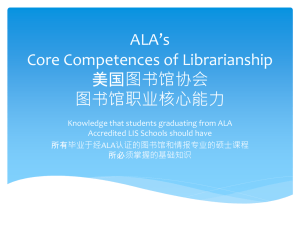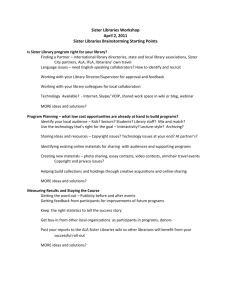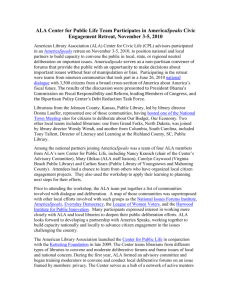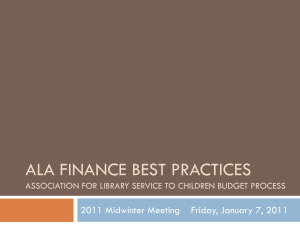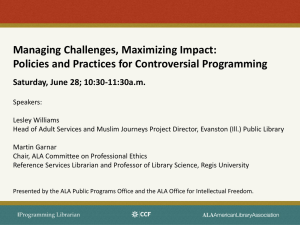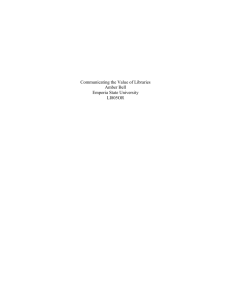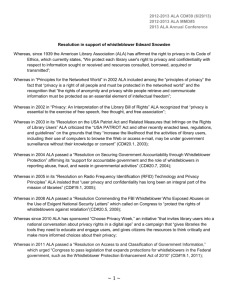ILS 503: Copyright
advertisement
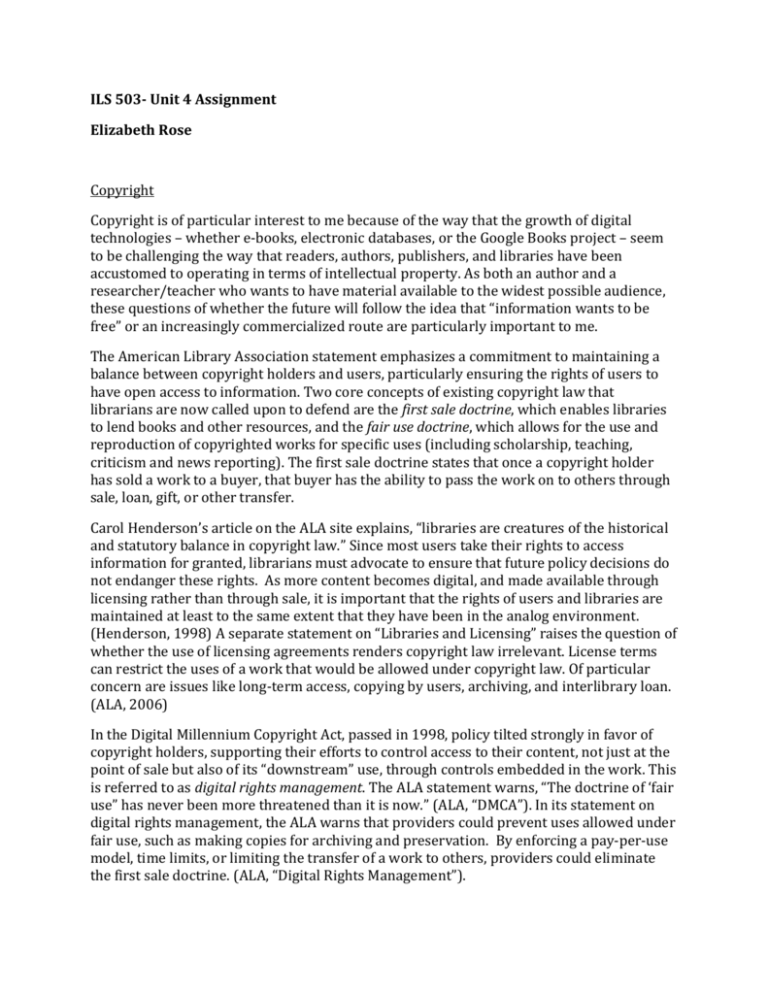
ILS 503- Unit 4 Assignment Elizabeth Rose Copyright Copyright is of particular interest to me because of the way that the growth of digital technologies – whether e-books, electronic databases, or the Google Books project – seem to be challenging the way that readers, authors, publishers, and libraries have been accustomed to operating in terms of intellectual property. As both an author and a researcher/teacher who wants to have material available to the widest possible audience, these questions of whether the future will follow the idea that “information wants to be free” or an increasingly commercialized route are particularly important to me. The American Library Association statement emphasizes a commitment to maintaining a balance between copyright holders and users, particularly ensuring the rights of users to have open access to information. Two core concepts of existing copyright law that librarians are now called upon to defend are the first sale doctrine, which enables libraries to lend books and other resources, and the fair use doctrine, which allows for the use and reproduction of copyrighted works for specific uses (including scholarship, teaching, criticism and news reporting). The first sale doctrine states that once a copyright holder has sold a work to a buyer, that buyer has the ability to pass the work on to others through sale, loan, gift, or other transfer. Carol Henderson’s article on the ALA site explains, “libraries are creatures of the historical and statutory balance in copyright law.” Since most users take their rights to access information for granted, librarians must advocate to ensure that future policy decisions do not endanger these rights. As more content becomes digital, and made available through licensing rather than through sale, it is important that the rights of users and libraries are maintained at least to the same extent that they have been in the analog environment. (Henderson, 1998) A separate statement on “Libraries and Licensing” raises the question of whether the use of licensing agreements renders copyright law irrelevant. License terms can restrict the uses of a work that would be allowed under copyright law. Of particular concern are issues like long-term access, copying by users, archiving, and interlibrary loan. (ALA, 2006) In the Digital Millennium Copyright Act, passed in 1998, policy tilted strongly in favor of copyright holders, supporting their efforts to control access to their content, not just at the point of sale but also of its “downstream” use, through controls embedded in the work. This is referred to as digital rights management. The ALA statement warns, “The doctrine of ‘fair use” has never been more threatened than it is now.” (ALA, “DMCA”). In its statement on digital rights management, the ALA warns that providers could prevent uses allowed under fair use, such as making copies for archiving and preservation. By enforcing a pay-per-use model, time limits, or limiting the transfer of a work to others, providers could eliminate the first sale doctrine. (ALA, “Digital Rights Management”). Another issue of concern related to copyright is how the Google Book settlement will affect libraries. This settlement will have little impact on in-copyright, commercially available (“in print”) books, and it does not apply to books published after January 2009. Most of the settlement focuses on the 70% of published books that are in copyright but not commercially available (“out of print”). For these books, Google will display up to 20% of the book’s content to public users, with different restrictions depending on the type of book. Users will not be able to print out or copy and paste the displays. Public libraries and non-profit educational institutions will get access to view the full-text of all books in the Google project at one public access terminal (in a public library; there could be more at a university library depending on the number of students enrolled at the institution). Libraries will also have different rights depending on their relationship with the Google Books project, and there will be institutional subscriptions as well as sales of individual works that are not commercially available to individual users. The TEACH Act This issue is of particular interest to me because as both an instructor and now as a student, I rely on services like Blackboard and electronic reserves to access and make available to students course readings and other materials. I also believe that some form of distance education will play an increasingly important role in higher education in the coming decades, so policy arrangements that are made now concerning copyrighted materials and other issues will have a large impact. The Technology, Education, and Copyright Harmonization (TEACH) Act of 2002 defines how non-profit educational institutions may use copyrighted materials in distance education without obtaining specific permission from the copyright owner or payment of royalties. The material in question applies not only to printed material, but also to artworks, videotapes, musical recordings, motion pictures, and computer programs, even if they have no visible copyright notice. Educators frequently incur possible violations of copyright whenever they use these materials in the classroom, although “fair use” has allowed copies, displays and performances of these works in the classroom. In a distance education setting, however, the standard for fair use is quite different, especially when material can be transmitted anywhere in the world, downloaded and possibly altered and re-transmitted for other purposes by students and other users. The law improves upon previous law by allowed the display and performance of nearly all types of works, and by expanding the locations where distance education can occur. The transmission of content must be only to students officially enrolled in the course, and must prevent students from downloading and further sharing or re-using it beyond the class session. Perhaps most importantly, the use of performances and displays of copyrighted materials must be an integral part of the class experience, directed by the instructor. Instructors may not use materials that are meant to be used by students outside the classroom (such as scanning and uploading chapters from a textbook rather than having students purchase it for their own use). The TEACH Act does not directly address librarians, but since librarians are (or should be) involved with resources for distance education, there will be opportunities to shape these programs in accordance with copyright law. Librarians are often best positioned to interpret and apply fair use to situations and needs not encompassed by the legislation, and may be responsible for gathering materials from their collections and licensed databases to include. Since fair use continues to apply to distance education, it may be an alternative that is less restrictive (although also less clear) than the provisions of the TEACH Act. Many of the law’s provisions are aimed at the educational institutions rather than individual instructors. These institutions must develop new policies, disseminate copyright information and impose restrictions on access (including being sure not to violate digital rights management controls). So one consequence of the law, according to Kenneth Crews, is that distance education programs will become increasingly centralized as colleges and universities require that all programs be transmitted solely on centralized systems that meet the standards for distribution of copyright information. Government Information Government information is of particular interest to me both because I rely on it at times in my research and teaching, and because it seems like a cornerstone of a democratic society that information produced by the government should be freely available to citizens. The ALA’s statement on government information explains that administrative barriers, ability to pay, geography, or format must not restrict the public’s right to access government information. The question of format may be particularly important in the years ahead as technological formats change rapidly, making it difficult to ensure that the choice of formats is not excluding some potential users. Government information is not restricted by copyright, since the people are ultimately the owners of the information produced by the government. Government responsibilities include collecting, maintaining, and disseminating information to the public, in a manner that “promotes its usefulness.” Government agencies must always consider formats that are useful to the public as well as to the agency, and make sure that information is comparable across geographic boundaries, and across time. (Certainly this latter stipulation is not always observed; for example, questions asked by the federal Census change over time.) Government must ensure both that the information provided to the public is full and complete and that individual rights to privacy are maintained. Depository library programs are a key way to provide widespread, no-fee public access to government information. Private sector involvement, including services offered by private publishers, should not replace the government’s responsibility to make information available to the public free of charge. (ALA, 2004) References American Library Association, “Digital Rights Management (DRM) & Libraries” (2010). Retrieved from http://www.ala.org/ala/issuesadvocacy/copyright/digitalrights/index.cfm on 9/22/10. American Library Association, “Distance Education and the TEACH Act” (2010). Retrieved from http://www.ala.org/Template.cfm?Section=Distance_Education_and_the_TEACH_Act&Tem plate=/ContentManagement/ContentDisplay.cfm&ContentID=25939 on 9/24/10. American Library Association, “DMCA: The Digital Millennium Copyright Act.” Retrieved from http://www.ala.org/ala/issuesadvocacy/copyright/dmca/index.cfm on 9/24/10. American Library Association, “Key Principles on Government Information” (2004). Retrieved from http://www.ala.org/ala/mgrps/rts/godort/communications/letters2004/principlesgovinfo.pdf on 9/24/10. American Library Association, “Libraries and Licensing” (2006). Retrieved from http://www.ala.org/ala/issuesadvocacy/copyright/librariesandlicensing/LibrariesAndLic ensing.cfm on 9/24/10. Jonathan Band, “A Guide for the Perplexed: Libraries and the Google Library Project Settlement” (2008). Retrieved from http://www.ala.org/ala/issuesadvocacy/copyright/googlebooks/index.cfm on 9/20/10. Kenneth Crews, “New Copyright Law for Distance Education: The Meaning and Importance of the TEACH Act.” Retrieved from http://www.ala.org/Template.cfm?Section=Distance_Education_and_the_TEACH_Act&Tem plate=/ContentManagement/ContentDisplay.cfm&ContentID=25939 on 9/20/10. Carol Henderson, “Libraries as Creatures of Copyright: Why Librarians Care About Intellectual Property Law and Policy” (1998). Retrieved from http://www.ala.org/ala/issuesadvocacy/copyright/copyrightarticle/librariescreatures.cf m on 9/22/10.

